高一英语外研版必修3module3教案设计
- 格式:doc
- 大小:205.36 KB
- 文档页数:10
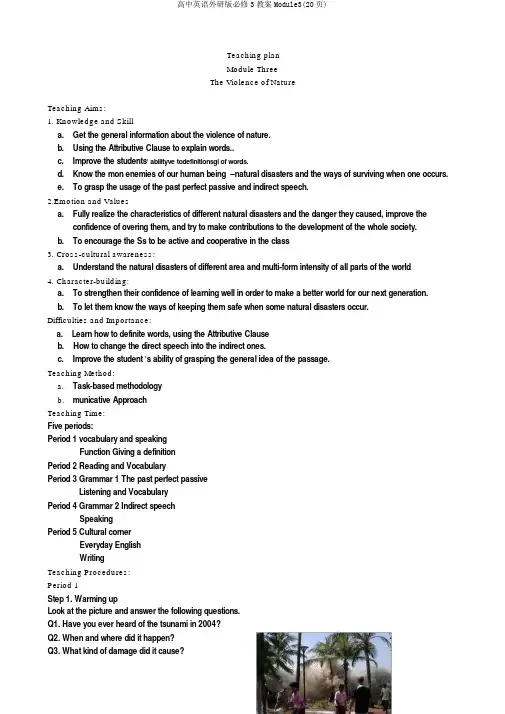
Teaching planModule ThreeThe Violence of NatureTeaching Aims:1.Knowledge and Skilla.Get the general information about the violence of nature.ing the Attributive Clause to explain words..c.Improve the students’ abilityve todefinitionsgi of words.d.Know the mon enemies of our human being –natural disasters and the ways of surviving when one occurs.e.To grasp the usage of the past perfect passive and indirect speech.2.Emotion and Valuesa.Fully realize the characteristics of different natural disasters and the danger they caused, improve theconfidence of overing them, and try to make contributions to the development of the whole society.b.To encourage the Ss to be active and cooperative in the class3.Cross-cultural awareness:a.Understand the natural disasters of different area and multi-form intensity of all parts of the world4.Character-building:a.To strengthen their confidence of learning well in order to make a better world for our next generation.b.To let them know the ways of keeping them safe when some natural disasters occur.Difficulties and Importance:a.Learn how to definite words, using the Attributive Clauseb.How to change the direct speech into the indirect ones.c.Improve the student ’s ability of grasping the general idea of the passage.Teaching Method:a.Task-based methodologyb.municative ApproachTeaching Time:Five periods:Period 1 vocabulary and speakingFunction Giving a definitionPeriod 2 Reading and VocabularyPeriod 3 Grammar 1 The past perfect passiveListening and VocabularyPeriod 4 Grammar 2 Indirect speechSpeakingPeriod 5 Cultural cornerEveryday EnglishWritingTeaching Procedures:Period 1Step 1. Warming upLook at the picture and answer the following questions.Q1. Have you ever heard of the tsunami in 2004?Q2. When and where did it happen?Q3. What kind of damage did it cause?Q4. Can you list some of other natural disasters?Q5. Tsunamis are natural occurrences. Can humanbeings stop them?Suggested answers:Q1. Yes.Q2. At the end of 2004, a massive earthquake sent tsunami smashing into Indian Ocean coastline. Many heavily populated areas disasters from it.Q3. Sri Lanka , Indonesia , Thailand , India, Malaysia and East Africa destroyed by the monster waves, causing millions of deaths.Q4. Flood, Fire, drought, landslide, earthquake, tornado, hurricane and so on.Q5. No. Tsunamis are a natural occurrence related to the processes that shape the Earth's surface — earthquakes, volcanoes, and landslides. These processes are driven by the heat escaping from the Earth and gravity, and people cannot control these underlying forces.Step 2. Vocabulary LearningMatch the words in the box with their definitions.Flood hurricane lightning thunderstorm tornado1. a lot of water in an area which is usually dry2. a very strong wind or storm3. a lot of rain falling quickly, with loud noises and flashes of light4.the flash of light which happens during a thunderstorm5. a column of air that turns very quickly.Each sentences gives a definition of a word.The Attributive Clause appears in each sentence.When we give a definit ion of a word, the Attributive Clause is usually necessary and hopeful. Welearn to use the structure“ A is B that/which”Step 4 PracticeGive definitions of the words following the pattern“ A is B that/which .”An earthquake a volcanic eruption a plane crashSuggested answers:1.An earthquake happens when the earth shakes because of movement underground.2. A volcanic eruption is that lava and ash ing out of a volcano.3. A plane crash is that a plane stopping flying and crashing into the earth.4.Which kind of these natural disasters have ever experienced? Can you describe it?5.Have you ever read a news story about one of the events? Can you describe it?6.Do you know anything about the events? For example, what causes them?Homework:1.Surf the Internet in order to have a better understanding of natural disasters.2.Preview the passage in Reading and Vocabulary.Period 2Step 1 Pre-readingRead about the Gulf Steam and check the meaning of the words:1, What is a current ?(a) A kind of electricity(b) A movement of water(c) A kind of wind2, What kind of things flow ?(a) Water(b) Time(c)Money3, If two places are on the same latitude ,they are on the same line _____(a)east/west(b)north/southSuggested answers:b. a . aa.SkimmingRead the passage quickly and silently. Find the words and expressions in the passages and match them with the definition.bury disaster feather fur occur tropical1 you can see this on an animal__________2 describing the hottest parts of the earth, north and south of the equator__________3 a terrible event_________4 you can see these on a bird_________5 to place in the ground or tomb ___________6 to happen __________Suggested answers:1. fur2. tropical3. disaster4. feather5. bury6. occurb. Detailed-reading1.How strong are tornado winds?2.What can happen to furniture when a house is destroyed by a tornado?3.How many tornadoes are there in the US every year?4.How many people died in the worst tornado of all time?5.What happens at sea during a hurricane?6.When was the worst hurricane of all time?7.Was the actor Charles Coghland killed in it?8.What happened to him after the hurricane?1.More than 400 km/h.2.It stays where it was.3.About 800.4.More than 700.5.It has huge waves.th6. 8September, 1900.7.No, he wasn ’t.8.His coffin was dropped in the sea by a hurricane and carried to Canada by the Gulf Stream.Step 3 Post-readingRead the passage again and fill in the form with suitable words.Tornado HurricaneDefinitionTimesPlacePhenomenaBad resultsThe worst example you knowSuggested answers:Tornado HurricaneDefinition A rotating column of Strong tropical storm.air from athunderstorm to theground.Times800in the US each 6 Atlantic hurricanesyear each yearPlace From Texas in the Occur in the southernsoutheast to South Atlantic Ocean,theDakota in the north Caribbean Sea and theGulf of MexicoPhenomena Have winds of more Violent winds of120than400kilometers kilometers per hour orper hour more,Bad results Pick up cars, trains Cause huge waves,and even houses and heavy rain and floodsput them down in thenext street;take thefur and feathers off;destroy houses butleave the furniturewhere it wasthThe worst example you know Occurred in 1925Occurred on the8September 1900inGalveston, Texas.Step 4 Language Explanations【条 1】occur【文原句】 Almost all of them occur in the US, in the area from Texas in the southeast to South Dakota in the north. (Page23)【点】 occur 此意“ 生” ,不及物,没有被。
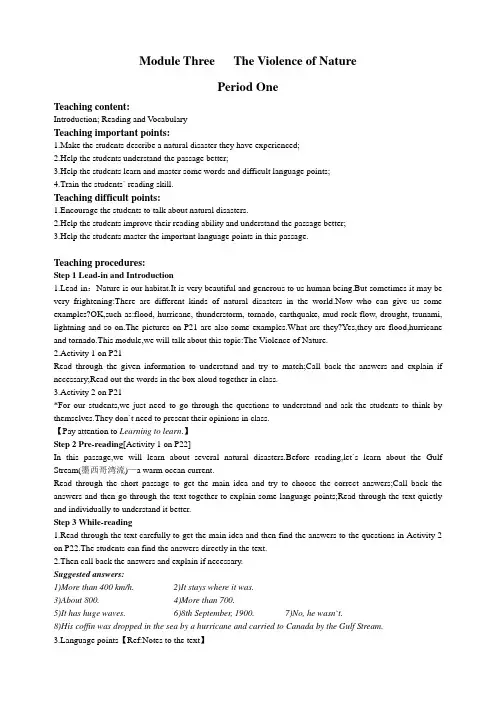
Module Three The Violence of NaturePeriod OneTeaching content:Introduction; Reading and V ocabularyTeaching important points:1.Make the students describe a natural disaster they have experienced;2.Help the students understand the passage better;3.Help the students learn and master some words and difficult language points;4.Train the students` reading skill.Teaching difficult points:1.Encourage the students to talk about natural disasters.2.Help the students improve their reading ability and understand the passage better;3.Help the students master the important language points in this passage.Teaching procedures:Step 1 Lead-in and Introduction1.Lead-in:Nature is our habitat.It is very beautiful and generous to us human being.But sometimes it may be very frightening:There are different kinds of natural disasters in the world.Now who can give us some examples?OK,such as:flood, hurricane, thunderstorm, tornado, earthquake, mud-rock flow, drought, tsunami, lightning and so on.The pictures on P21 are also some examples.What are they?Yes,they are flood,hurricane and tornado.This module,we will talk about this topic:The Violence of Nature.2.Activity 1 on P21Read through the given information to understand and try to match;Call back the answers and explain if necessary;Read out the words in the box aloud together in class.3.Activity 2 on P21*For our students,we just need to go through the questions to understand and ask the students to think by themselves.They don`t need to present their opinions in class.【Pay attention to Learning to learn.】Step 2 Pre-reading[Activity 1 on P22]In this passage,we will learn about several natural disasters.Before reading,let`s learn about the Gulf Stream(墨西哥湾流)—a warm ocean current.Read through the short passage to get the main idea and try to choose the correct answers;Call back the answers and then go through the text together to explain some language points;Read through the text quietly and individually to understand it better.Step 3 While-reading1.Read through the text carefully to get the main idea and then find the answers to the questions in Activity 2 on P22.The students can find the answers directly in the text.2.Then call back the answers and explain if necessary.Suggested answers:1)More than 400 km/h. 2)It stays where it was.3)About 800. 4)More than 700.5)It has huge waves. 6)8th September, 1900. 7)No, he wasn`t.8)His coffin was dropped in the sea by a hurricane and carried to Canada by the Gulf Stream.nguage points【Ref:Notes to the text】Go through the text together with the students to explain some language points.4.Read through the text again quietly and individually to understand it better.Time permitting,listen to the tape and follow it.Step 4 Post-reading[Activity 3 on P22]Read through the given information to understand it and try to match;Call back the answers and explain if necessary;Read out the words in the box aloud together.Step 5 Summary and Homework1.Summary: Summarize what they have learned in this period.2.Homework: Reading on P81-82 in workbook.Appendix: Notes to the text1.occur vi.▲(1)发生[=happen,take place(强调按计划)]e.g:The accident occurred at five o`clock.(=happen)▲(2)想起,想到(与to 连用)sth. occurs to sb. OR It occurs to sb. that clause(主语从句) 某人突然想起…e.g: An excellent idea occurred to me when I woke up this morning.It occurred to me that I would travel Europe.2.They can destroy houses,but leave the furniture inside exactly where it was.▲leave + O. + OC.“使…处于某状态”,宾补可以是介词短语、形容词、分词等。
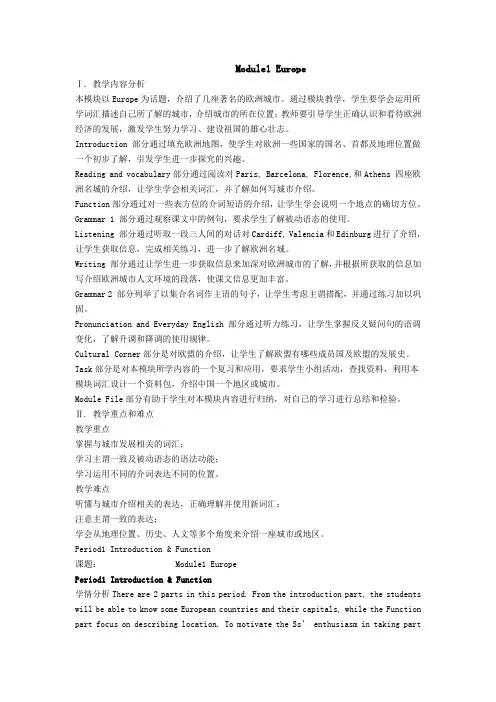
Module1 EuropeⅠ. 教学内容分析本模块以Europe为话题,介绍了几座著名的欧洲城市。
通过模块教学,学生要学会运用所学词汇描述自己所了解的城市,介绍城市的所在位置;教师要引导学生正确认识和看待欧洲经济的发展,激发学生努力学习、建设祖国的雄心壮志。
Introduction 部分通过填充欧洲地图,使学生对欧洲一些国家的国名、首都及地理位置做一个初步了解,引发学生进一步探究的兴趣。
Reading and vocabulary部分通过阅读对Paris, Barcelona, Florence,和Athens 四座欧洲名城的介绍,让学生学会相关词汇,并了解如何写城市介绍。
Function部分通过对一些表方位的介词短语的介绍,让学生学会说明一个地点的确切方位。
Grammar 1 部分通过观察课文中的例句,要求学生了解被动语态的使用。
Listening 部分通过听取一段三人间的对话对Cardiff, Valencia和Edinburg进行了介绍,让学生获取信息,完成相关练习,进一步了解欧洲名城。
Writing 部分通过让学生进一步获取信息来加深对欧洲城市的了解,并根据所获取的信息加写介绍欧洲城市人文环境的段落,使课文信息更加丰富。
Grammar 2 部分列举了以集合名词作主语的句子,让学生考虑主谓搭配,并通过练习加以巩固。
Pronunciation and Everyday English 部分通过听力练习,让学生掌握反义疑问句的语调变化,了解升调和降调的使用规律。
Cultural Corner部分是对欧盟的介绍,让学生了解欧盟有哪些成员国及欧盟的发展史。
Task部分是对本模块所学内容的一个复习和应用,要求学生小组活动,查找资料,利用本模块词汇设计一个资料包,介绍中国一个地区或城市。
Module File部分有助于学生对本模块内容进行归纳,对自己的学习进行总结和检验。
Ⅱ. 教学重点和难点教学重点掌握与城市发展相关的词汇;学习主谓一致及被动语态的语法功能;学习运用不同的介词表达不同的位置。
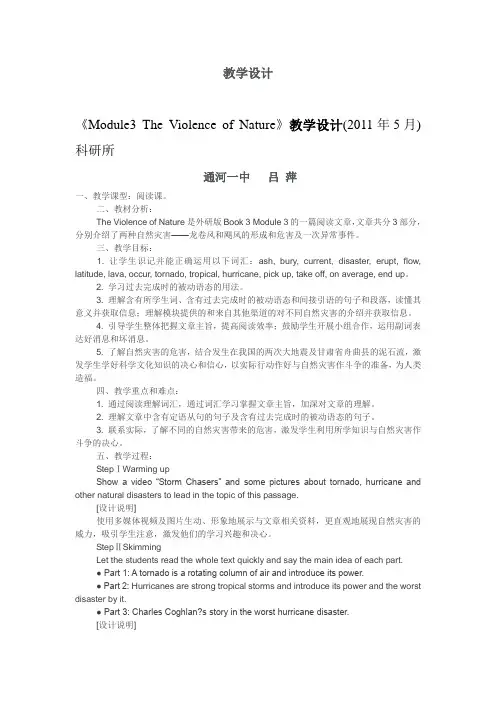
教学设计《Module3 The Violence of Nature》教学设计(2011年5月)科研所通河一中吕萍一、教学课型:阅读课。
二、教材分析:The Violence of Nature是外研版Book 3 Module 3的一篇阅读文章,文章共分3部分,分别介绍了两种自然灾害——龙卷风和飓风的形成和危害及一次异常事件。
三、教学目标:1. 让学生识记并能正确运用以下词汇:ash, bury, current, disaster, erupt, flow, latitude, lava, occur, tornado, tropical, hurricane, pick up, take off, on average, end up。
2. 学习过去完成时的被动语态的用法。
3. 理解含有所学生词、含有过去完成时的被动语态和间接引语的句子和段落,读懂其意义并获取信息;理解模块提供的和来自其他渠道的对不同自然灾害的介绍并获取信息。
4. 引导学生整体把握文章主旨,提高阅读效率;鼓励学生开展小组合作,运用副词表达好消息和坏消息。
5. 了解自然灾害的危害,结合发生在我国的两次大地震及甘肃省舟曲县的泥石流,激发学生学好科学文化知识的决心和信心,以实际行动作好与自然灾害作斗争的准备,为人类造福。
四、教学重点和难点:1. 通过阅读理解词汇,通过词汇学习掌握文章主旨,加深对文章的理解。
2. 理解文章中含有定语从句的句子及含有过去完成时的被动语态的句子。
3. 联系实际,了解不同的自然灾害带来的危害,激发学生利用所学知识与自然灾害作斗争的决心。
五、教学过程:StepⅠWarming upShow a video “Storm Chasers” and some pictures about tornado, hurricane and other natural disasters to lead in the topic of this passage.[设计说明]使用多媒体视频及图片生动、形象地展示与文章相关资料,更直观地展现自然灾害的威力,吸引学生注意,激发他们的学习兴趣和决心。
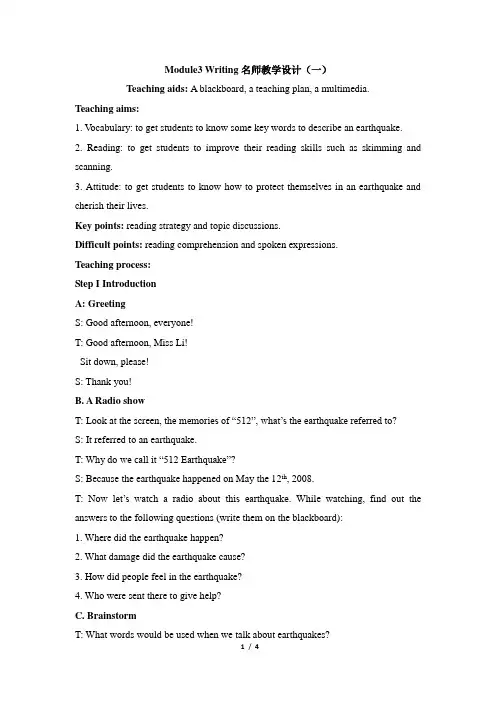
Module3 Writing名师教学设计(一)Teaching aids: A blackboard, a teaching plan, a multimedia.Teaching aims:1. V ocabulary: to get students to know some key words to describe an earthquake.2. Reading: to get students to improve their reading skills such as skimming and scanning.3. Attitude: to get students to know how to protect themselves in an earthquake and cherish their lives.Key points: reading strategy and topic discussions.Difficult points: reading comprehension and spoken expressions.Teaching process:Step I IntroductionA: GreetingS: Good afternoon, everyone!T: Good afternoon, Miss Li!Sit down, please!S: Thank you!B. A Radio showT: Look at the screen, the memories of “512”, what’s the earthquake referred to?S: It referred to an earthquake.T: Why do we call it “512 Earthquake”?S: Because the earthquake happened on May the 12th, 2008.T: Now let’s watch a radio about this earthquake. While watching, find out the answers to the following questions (write them on the blackboard):1. Where did the earthquake happen?2. What damage did the earthquake cause?3. How did people feel in the earthquake?4. Who were sent there to give help?C. BrainstormT: What words would be used when we talk about earthquakes?S: Events: Tangshan, Yushu, Tokyo, San Francisco.Damage: homes, buildings, lives, money.Feelings: sad, nervous, lonely.Rescue Work: doctors, nurses, soldiers, firefighters.Step II Reading ActivitiesA. SkimmingT: As we all know, this passage is about earthquake and this word is very important and appears many times, so it is the key word of the whole passage. Can you find out the key word of each paragraph?S: Part 1(Paragraph 1---worldwide):An introduction: how often earthquakes occurPart 2(Paragraph 2: Hua County):An example: earthquake in China (Hua County)Part 3(Paragraph 3-5: California)Another example: earthquake in the USA (California)B. ScanningT: Which paragraph does the data appear?What’s the data referred to?400 times/day 800 k㎡60% 830, 0005: 15 a. m. 1906-4-1825, 000 500250, 000 3, 000C. SummaryAbout 400 earthquakes occur worldwide per day and over 100, 000 per year. Step III Earthquake DrillsA. In the ClassroomWhat can we do to keep ourselves safe in an earthquake?1. Run out of the classroom as quickly as possible. (F)2. Jump out of the window. (F)3. Stay still. (F)4. Lean against the wall. (F)5. Hide under the desk. (T)6. Use a lift. (F)7. Keep calm. (T)B. In Other SituationsSupermarket: lean against the corner of wallIn the field: lean against the rockOutdoors: stay stillAt home: hide under the desk or the bedIn the cinema: hide under the chairC. TipsLife is only once.We must cherish our life.In an earthquake,SPEED IS LIFE.Step IV HomeworkThe earthquake is coming, but you can take only three things. What will they be? Why will you choose them?教学反思1. 视频导入,为整堂课定下基调。
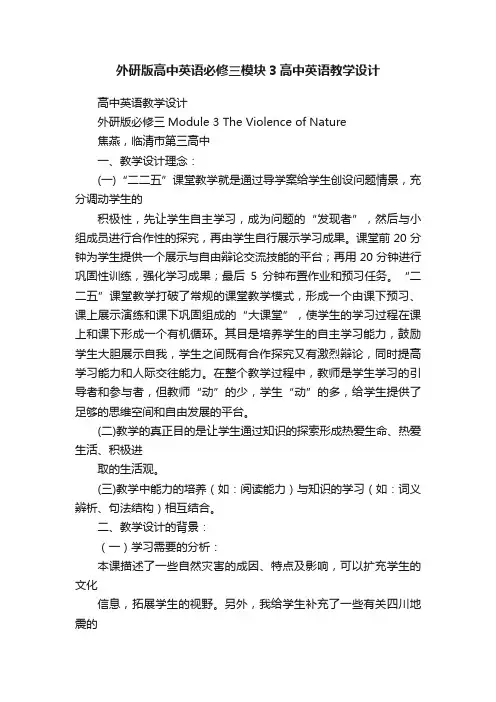
外研版高中英语必修三模块3高中英语教学设计高中英语教学设计外研版必修三Module 3 The Violence of Nature焦燕,临清市第三高中一、教学设计理念:(一)“二二五”课堂教学就是通过导学案给学生创设问题情景,充分调动学生的积极性,先让学生自主学习,成为问题的“发现者”,然后与小组成员进行合作性的探究,再由学生自行展示学习成果。
课堂前20分钟为学生提供一个展示与自由辩论交流技能的平台;再用20分钟进行巩固性训练,强化学习成果;最后5分钟布置作业和预习任务。
“二二五”课堂教学打破了常规的课堂教学模式,形成一个由课下预习、课上展示演练和课下巩固组成的“大课堂”,使学生的学习过程在课上和课下形成一个有机循环。
其目是培养学生的自主学习能力,鼓励学生大胆展示自我,学生之间既有合作探究又有激烈辩论,同时提高学习能力和人际交往能力。
在整个教学过程中,教师是学生学习的引导者和参与者,但教师“动”的少,学生“动”的多,给学生提供了足够的思维空间和自由发展的平台。
(二)教学的真正目的是让学生通过知识的探索形成热爱生命、热爱生活、积极进取的生活观。
(三)教学中能力的培养(如:阅读能力)与知识的学习(如:词义辨析、句法结构)相互结合。
二、教学设计的背景:(一)学习需要的分析:本课描述了一些自然灾害的成因、特点及影响,可以扩充学生的文化信息,拓展学生的视野。
另外,我给学生补充了一些有关四川地震的图片和英文报道,激发学生用英语获取知识和解决问题的兴趣。
(二)学习内容的分析:外研版英语教材中的每一个单元都是围绕一个独立的话题展开,包括听、说、读、写等综合技能的训练。
本单元为高一必修三第三模块,教学内容为描述自然灾害。
目的是让学生通过完成本模块的任务,能够对所学语言灵活运用,熟练掌握有关自然灾害这一话题词汇和表达句型。
并通过模块学习使学生了解地震、飓风、龙卷风等各种自然灾害的成因、过程及所造成的严重后果。
培养学生对自然科学知识的渴求,对美好生活的热爱,激发他们学好自然科学服务于生活的热情。
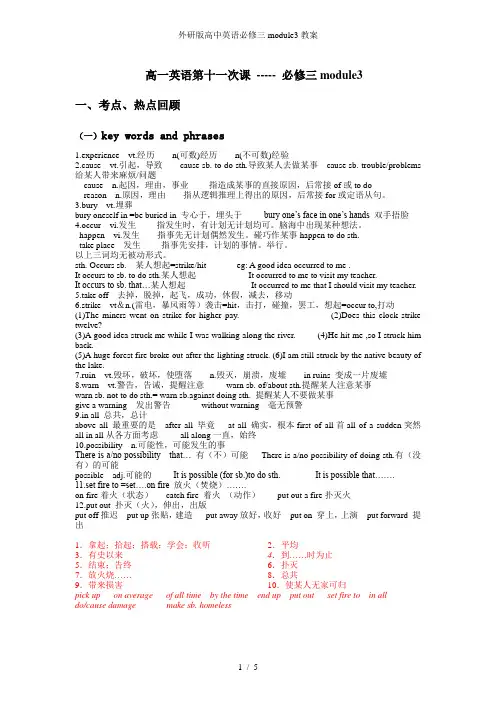
外研版高中英语必修三module3教案高一英语第十一次课----- 必修三module3一、考点、热点回顾(一)key words and phrases1.experience vt.经历n(可数)经历n(不可数)经验2.cause vt.引起,导致cause sb. to do sth.导致某人去做某事cause sb. trouble/problems 给某人带来麻烦/问题cause n.起因,理由,事业-------指造成某事的直接原因,后常接of或to doreason n.原因,理由------指从逻辑推理上得出的原因,后常接for或定语从句。
3.bury vt.埋葬bury oneself in =be buried in 专心于,埋头于bury one’s face in one’s hands 双手捂脸4.occur vi.发生-------指发生时,有计划无计划均可。
脑海中出现某种想法。
happen vi.发生------指事先无计划偶然发生。
碰巧作某事happen to do sth.take place 发生-------指事先安排,计划的事情。
举行。
以上三词均无被动形式。
sth. Occurs sb. 某人想起=strike/hit eg: A good idea occurred to me .It occurs to sb. to do sth.某人想起It occurred to me to visit my teacher.It occurs to sb. that…某人想起It occurred to me that I should visit my teacher.5.take off 去掉,脱掉,起飞,成功,休假,减去,移动6.strike vt&n.(雷电,暴风雨等)袭击=hit,击打,碰撞,罢工,想起=occur to,打动(1)The miners went on strike for higher pay. (2)Does this clock strike twelve?(3)A good idea struck me while I was walking along the river. (4)He hit me ,so I struck him back.(5)A huge forest fire broke out after the lighting struck. (6)I am still struck by the native beauty of the lake.7.ruin vt.毁坏,破坏,使堕落n.毁灭,崩溃,废墟in ruins 变成一片废墟8.warn vt.警告,告诫,提醒注意warn sb. of/about sth.提醒某人注意某事warn sb. not to do sth.= warn sb.against doing sth. 提醒某人不要做某事give a warning 发出警告without warning 毫无预警9.in all 总共,总计above all 最重要的是after all 毕竟at all 确实,根本first of all首all of a sudden突然all in all从各方面考虑all along一直,始终10.possibility n.可能性,可能发生的事There is a/no possibility that… 有(不)可能There is a/no possibility of doing sth.有(没有)的可能possible adj.可能的It is possible (for sb.)to do sth. It is possible that…….11.set fire to =set….on fire 放火(焚烧)…….on fire着火(状态)catch fire 着火(动作)put out a fire扑灭火12.put out 扑灭(火),伸出,出版put off推迟put up张贴,建造put away放好,收好put on 穿上,上演put forward 提出1.拿起;拾起;搭载;学会;收听2.平均3.有史以来4.到……时为止5.结束;告终6.扑灭7.放火烧…… 8.总共9.带来损害10.使某人无家可归pick up on average of all time by the time end up put out set fire to in alldo/cause damage make sb. homeless选词填空in all,set fire to,by the time,pick up,on average1. __________ you arrive, I will have left.2.__________, I spend two hours doing my homework every day.3.Sorry, I have to go to _______ my son from school.4.How much money does he owe you ______?5.Have the police found out who ________ the building?(二)Language PointsOn average, there are800 trnadoes in the US each year, causing about 80 deaths and 1,500 injuries.现在分词短语作结果状语The fire burned for 3 days, destroying a total of 25,000 buildings.现在分词短语作结果状语表自然而然的结果。

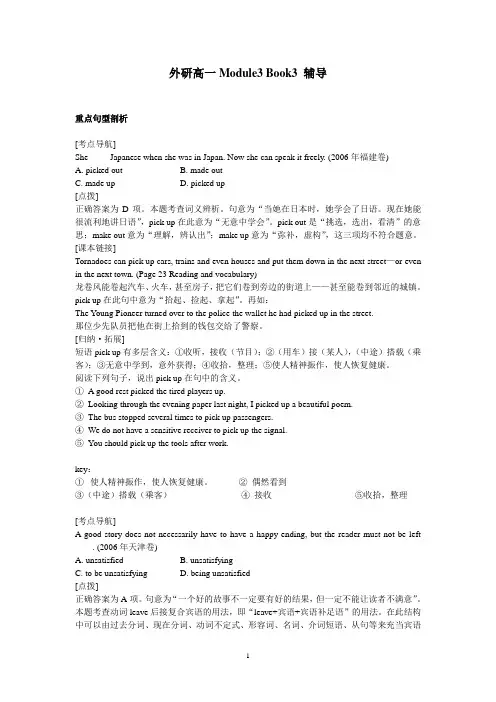
外研高一Module3 Book3 辅导重点句型剖析[考点导航]She ____ Japanese when she was in Japan. Now she can speak it freely. (2006年福建卷)A. picked outB. made outC. made upD. picked up[点拨]正确答案为D项。
本题考查词义辨析。
句意为“当她在日本时,她学会了日语。
现在她能很流利地讲日语”,pick up在此意为“无意中学会”。
pick out是“挑选,选出,看清”的意思;make out意为“理解,辨认出”;make up意为“弥补,虚构”,这三项均不符合题意。
[课本链接]Tornadoes can pick up cars, trains and even houses and put them down in the next street—or even in the next town. (Page 23 Reading and vocabulary)龙卷风能卷起汽车、火车,甚至房子,把它们卷到旁边的街道上——甚至能卷到邻近的城镇。
pick up在此句中意为“拾起、捡起、拿起”。
再如:The Young Pioneer turned over to the police the wallet he had picked up in the street.那位少先队员把他在街上拾到的钱包交给了警察。
[归纳·拓展]短语pick up有多层含义:①收听,接收(节目);②(用车)接(某人),(中途)搭载(乘客);③无意中学到,意外获得;④收拾,整理;⑤使人精神振作,使人恢复健康。
阅读下列句子,说出pick up在句中的含义。
①A good rest picked the tired players up. ___________②Looking through the evening paper last night, I picked up a beautiful poem. ___________③The bus stopped several times to pick up passengers. ___________④We do not have a sensitive receiver to pick up the signal. ___________⑤You should pick up the tools after work. ___________key:①使人精神振作,使人恢复健康。

Part Two Teaching Resources第二部分教学资源Section 1 Background readings for Module 3 The Violenceof Nature1. latitudeLatitude, angular distance of any point on the surface of the earth north or south of the equator. The equator is latitude 0°, and the North Pole and South Pole are latitudes 90°N and 90°S, respectively.2. lavaLava is molten rock that a volcano expels during an eruption. Lava, when first exuded from a volcanic vent, is a liquid at very high temperature: typically from 700°C to 1200°C (1300°F to 2200°F). Although the viscosity of lava is 100,000 times that of water, the viscous rock can flow many miles before eventually cooling and solidifying.3. Ten deadliest natural disastersSection 2 The Analysis of the Difficult Sentences fromModule 3 The Violence of Nature1.They can destroy houses, but leave the furniture inside exactly where it was. 他们能完全地破坏房子, 但是房子里面的家具却能留在原处。
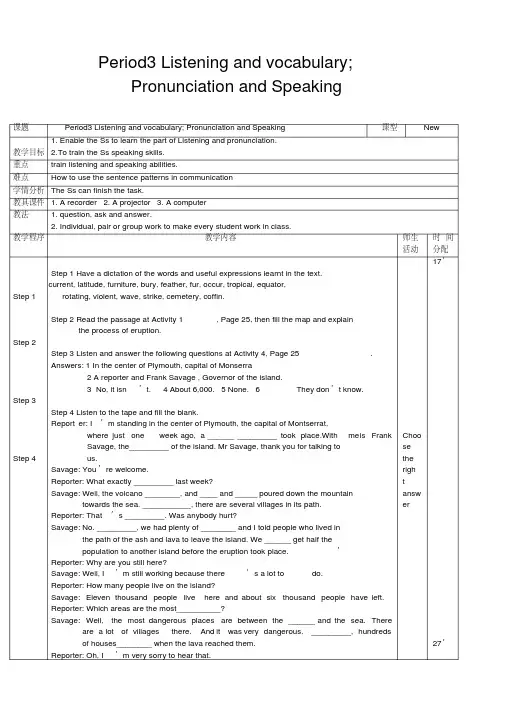
Period3 Listening and vocabulary;Pronunciation and Speaking课题Period3 Listening and vocabulary; Pronunciation and Speaking 课型New教学目标1. Enable the Ss to learn the part of Listening and pronunciation.2.To train the Ss speaking skills.重点train listening and speaking abilities.难点How to use the sentence patterns in communication学情分析The Ss can finish the task.教具课件 1. A recorder 2. A projector 3. A computer教法 1. question, ask and answer.2. Individual, pair or group work to make every student work in class.教学程序教学内容师生活动时间分配Step 1 Step 2 Step 3 Step 4 Step 1 Have a dictation of the words and useful expressions learnt in the text.current, latitude, furniture, bury, feather, fur, occur, tropical, equator,rotating, violent, wave, strike, cemetery, coffin.Step 2 Read the passage at Activity 1, Page 25, then fill the map and explain the process of eruption.Step 3 Listen and answer the following questions at Activity 4, Page 25.Answers: 1 In the center of Plymouth, capital of Monserra2 A reporter and Frank Savage , Governor of the island.3 No, it isn’t.4 About 6,000.5 None.6 They don’t know.Step 4 Listen to the tape and fill the blank.Report er: I’m standing in the center of Plymouth, the capital of Montserrat,where just one week ago, a ______ _________ took place.With me i s FrankSavage, the_________ of the island. Mr Savage, thank you for talking tous.Savage: You’re welcome.Reporter: What exactly _________ last week?Savage: Well, the volcano ________, and ____ and _____ poured down the mountain towards the sea. ___________, there are several villages in its path.Reporter: That’s _________. Was anybody hurt?Savage: No. _________, we had plenty of ________ and I told people who lived in the path of the ash and lava to leave the island. We ______ get half thepopulation to another island before the eruption took place.’ Reporter: Why are you still here?Savage: Well, I’m still working because there’s a lot to do.Reporter: How many people live on the island?Savage: Eleven thousand people live here and about six thousand people have left. Reporter: Which areas are the most__________?Savage: Well, the most dangerous places are between the ______ and the sea. There are a lot of villages there. And it was very dangerous. _________, hundreds of houses________ when the lava reached them.Reporter: Oh, I’m very sorry to hear that.Choosetherightanswer17’27’Step 5 Savage: _____________, no one was killed.Reporter: Are the houses still _____ _______?Savage: No. Fortunately, we _____ all the fires _____ quite quickly.Reporter: That’s very good news. Well, it’s a beautiful sunny day here in Plymouth.Does this mean that the danger ________?Savage: No! The volcano could erupt again! People must understand that it is still very dangerous and they can’t ________to their houses.Reporter: OK-So that’s the message from th e governor_______________. When will people be able to return home?Savage: We don’t know at the moment.____________, it won’t be too long. Reporter: Thank you for your time, Mr Savage.Savage: Thank you.Step 5 PronunciationListen and underline the words which the speaker stresses. These key words contain the main ideas.板书 Period3 Listening and vocabulary; Pronunciation and Speaking current, latitude, furniture, bury, feather, fur,occur, tropical, equator, rotating,violent, wave, strike, cemetery, coffin.教学后记So many usage for Ss.。
Module 3 The violence of naturePeriod 1 Introduction and Cultural cornerRead the article and answer the questions. P291.Where was the worst Chinese earthquake?2.What was the most dangerous thing about the California Earthquake of 1906?3.Is it possible that there could be another earthquake there?Careful reading (Para 1-2)True or False:1.About 500 earthquakes happen worldwide every day. ( )2.China is located in one of the most active earthquake regions in the world. ( )3.The earthquake in Shaanxi Province affected seven provinces in China. ( )4.The earthquake covered an area of 800 square kilometres. ( )5.There were 830,000 people who lost their homes. ( )Careful reading (Para 1-2) Fill in the blanks:China is______ in one of the most active earthquake regions in the world.One of the most serious _______ in Hua County in Shaanxi Province in 1556.The earthquake _______ eight provinces in Central China.It _______ an area of 800 square kilometers._______, 830,000 people _____________.Careful reading (Para 3-5)Answer the questions:1.Which earthquake was the worst in the US?2.How long did it last?3.How many buildings were destroyed by the fire which was caused by earthquake?4.Was the damage big? How many people died in the earthquake?5.What caused the earthquake?Fill in the blanks:The _____ earthquake in the US occurred in 1906 .It ____for a minute.It caused fires which destroyed __ ____ ___25,000 buildings.The earthquake and fires caused about 3,000______.The earthquake was caused by a _______ on the San Andreas Fault.One hundred years _____, movements on the San Andreas Fault ________ to cause problems for the whole of California.Language points of the cultural cornerPhrases1.be situated in2.the most active earthquake regions3.cover an area of4.lose one’s lifest for6.the worst natural disaster7.do damage8.make sb homeless9.in the whole of10.be caused bySentences1.About 400 earthquake occur worldwide every day, more than a hundred thousand in a year.(para.1)occur: vi.to happen 发生(不用于被动语态)occur---occurred---occurred---occurring他告诉我那事故是怎样发生的。
Module 3 The Violence of Nature本单元以“自然灾害”(The violence of nature)为话题,旨在通过单元教学,让学生运用书中的Useful expressions编对话,描述人物,事件和人物的感情,了解人们在自然灾害中的经历、感受,提高学生的自我保护意识;培养学生对定语从句的运用能力,词汇部分训练学生在语境中理解词汇的能力,学习对词语进行解释,以及如何运用useful expressions暗示之后的语言内容。
本单元的话题是“自然灾害”,其中包括“龙卷风”、“飓风”、“火山爆发”、“地震”、“洪水”等。
【总体目标】Learn to use the Indirect Speech and learn to use the Past Perfect Passive.Write about a natural disaster.Write a passage using everyday English that indicate the good or bad things to happen.Learn to give definitions of a word with Attribute Clause.【词汇】1.基础词汇:disaster, flood, hurricane, lightening, thunderstorm, tornado, column, experience, cause, current, furniture, bury, feather, fur, occur, violent, wave, strike, cemetery, rotating, coffin, previous, eruption, ruin, ash, lava, tidal, volcano, possibility, earthquake, terrifying, luckily, thankfully, hopefully, sadly, fortunately, warning, worldwide, active, damage.2. 认读词汇:latitude, tropical, equator.3. 词组:per hour, pick up, put…down, take off, on averag e, tropical storms, in a population of, tiny island, tidal wave, pour down, set fire, volcanic eruption, take place, move from side to side, be windy, be situated in, Central China, in all, lose one’s life, do the most damage, a total of, affected areas, p ush…out of, fall down, medical care【句子】1.They can destroy houses, but leave the furniture inside exactly where it was.2.On average, there are 800 tornadoes in the US each year, causing about 80 deaths and 1,500 injuries.3.By the time it ended, more than 700 people had been killed and 2,700 had been injured.4.The disaster killed 6,000 people in a population of 37,000 and destroyed 3,600 buildings.5.When the lava reached the sea, there was the possibility of a huge tidal wave which could flood half the island.6. Fires caused by the California Earthquake did the most damage.7. The earthquake has left tens of thousands of people homeless.8. My family had just finished breakfast when the house started shaking and we heard a loud noise.9. At night it is very cold in the region with temperatures falling结构:The Past Perfect Passive Sb had done sth. Sth had been done.Indirect Speech 1. Statements “I’m still working because there is a lot to do.” he said. He said that he was still working because there was a lot to do.2. Questions “Does this mean that the danger is over?” he asked. He asked if this meant that the danger was over. “When will people be able to return home?” asked he. He asked when peoplea. Learn how to definite words, using the Attributive Clauseb.How to change the direct speech into the indirect ones. c. Improve the student’s ability of grasping the general idea of the passage.多媒体课件辅助。
Module 3 The Violence of NatureI. 教学内容分析本模块以The Violence of Nature为话题,介绍了几种常见的自然灾害,旨在让学生了解自然灾害的危害,以及它们存在的自然及地理环境。
通过本模块的学习,学生要了解自然灾害的特征,并且能够描述灾害发生时所发生的场景,懂得如何在灾难中避险。
Introduction部分通过几幅自然灾害照片引出本模块的内容,让学生对自然灾害有一个直观形象的认识,为本模块的学习打下基础。
Reading and Vocabulary部分通过阅读,使学生了解了两种生成于海上的自然灾害,并学习相关的词汇,着重培养学生快速寻找细节的技巧。
为后面的听、说、读、写训练打下基础。
Grammar 1部分通过观察课文中出现的句子,重点复习过去完成被动语态的语法概念。
Listening and Vocabulary部分,通过一篇短文介绍了加勒比海中的一个美丽岛屿,为听力材料提供了背景,也解决了听力部分的一些词汇问题。
通过练习,让学生了解了火山爆发时的情景,培养学生听大意和细节的能力。
Grammar 2部分通过阅读听力部分的句子及改编后的句子,让学生复习了由直接引语变间接引语的规律。
Pronunciation部分实际上是听力部分的延伸,学生通过这一部分的学习,可以培养通过听单词重音来了解所听语段大意的能力。
Speaking部分,围绕本模块的中心,培养学生在采访中如何提出问题、回答问题的能力,提高会话技巧。
Function部分培养学生根据以知的词汇来为新词下定义的能力,引导他们用英语进行思维。
Writing部分给出参照,让学生描述某一自然灾害的时间、地点、经过、结果等一般情况。
Everyday English部分通过置于句首作状语的副词,来了解整个句子所表达的情感态度。
Cultural Corner部分通过描述历史上两次不同的地震,让学生了解地震的危害,进而思考在地震中应如何避险。
II. 教学重点和难点1. 教学重点(1) 了解一些自然灾害的词汇及基本常识;(2) 快速浏览课文抓住中心内容;(3) 置于句首表明作者态度的副词。
2. 教学难点(1) 听力练习;(2) 过去完成时态;(3) 根据句子重音听语段主要意思。
III. 教学计划本模块共分五课时:第一课时:Introduction, Function, Cultural Corner第二课时:Reading and Vocabulary第三课时:Listening and Vocabulary, Pronunciation, Everyday English第四课时:Grammar 1, Grammar 2第五课时:Speaking, Writing, Module FileIV.教学步骤Period 1 Introduction, Function, Cultural CornerTeaching Goals:1. To introduce some words of natural disasters.2. To help Ss define the words with their own words.3. To help Ss to find the key information by comparison.Teaching Procedures:Step 1. Introduction1. Introduce some natural disasters by asking Ss about the weather.Q1. What’s the weather like today?Q2. What will happen when there is too little rain?2. Introduce some pictures about natural disasters.Step 2. Function1. Ask Ss to define the natural disasters in the pictures above in their own words. Suggested Answers:(1) A drought is a long period of time when there is not enough water.(2) A flood is a lot of water in an area which is usually dry.(3) A volcanic eruption is the explosion of melting rocks and gases and so on from the inside of the earth.(4) An earthquake is a sudden shaking of the earth’s surface.(5) A tsunami is an extremely large wave in the sea caused by an earthquake.(6) A lightening is the flash of light which occurs during a thunderstorm. 2.Ask Ss to discuss these questions in groups:Q1. Have you ever experienced a thunderstorm/ a flood/ a hurricane…?Q2. Have you ever read a news story about one of these events? Can you describe it?Q3. Do you know anything about the events? For example, what causes them? Step 3. Cultural Corner1. Fast readingAsk Ss to scan the text quickly to get the structure of the passage. Suggested Answers:Part 1 (Para. 1): There are many earthquakes in the world.Part 2 (Para 2): The worst ever earthquake in China.Part 3 (Paras 3~5): The worst ever earthquake in the USA and its cause.2. Intensive readingAsk Ss to read the passage carefully and fill in the form.(1) Hua County (2) 1556 (3) affected (4) covered (5) were (6) in all(7) lost their lives (8) located in (9) California (10) the 18th of April, 1906(11) caused (12) damage (13) homeless (14) whole (15) movement3. Ask Ss to discuss in groups what they can do if there is an earthquake, then collect the answers.Step 4. Homework1. Ask Ss to go over what they have learnt in the module.2. Ask Ss to preview Reading and Vocabulary on page 23.Period 2 Vocabulary and ReadingTeaching Goals:1.To get Ss to have the general idea of the reading passages.2. To get Ss to know some facts of the two disasters.Teaching Procedures:Step 1. RevisionAsk Ss to translate the following sentences.1. 地震影响到了方圆100公里的一块区域,共有10人丧生。
2. 我们学校坐落在一座小山上。
3. 开发区人口的70%都是年轻人。
Suggested Answers:1. The earthquake covered an area of 100 square kilometers. In all, 10 people lost their lives.2. Our school is situated on a small hill.3. Seventy percent of the population in the development zone are youths.Step 2. Fast reading1. Ask Ss to Read the short passage about the Gulf Stream in Activity 1 on page 22 and guess the meaning of the words “current”, “flow” and “latitude”. Then give them the right answers.2. Get Ss to read the passage and summarize the main idea of each passage. Then ask them to discuss their answers in groups.Suggested Answers:Passage 1: Tornado and its great force.Passage 2: Hurricane and the worst example.Passage 3: An extraordinary story about the 1900 Galveston hurricane.Step 3. Intensive reading可以自己出一些题目1. Ask Ss to read the passage carefully and finish Activity 2 on Page 22.2. Ask Ss to find the words and expressions of Activity 3 in the passage. Then let them match them with the definitions.3. Ask Ss to read the passages again and then discuss the difference between tornado and hurricane.Step 4. Language Points.Ask Ss to discuss the language points in the reading passages in groups.1. Tornado can pick up cars, trains and even houses … (Line 1, Para 2,Passage 1) 龙卷风可以卷起汽车、火车甚至房子,然后把它们带到下一个街区,甚至是另一个城镇。